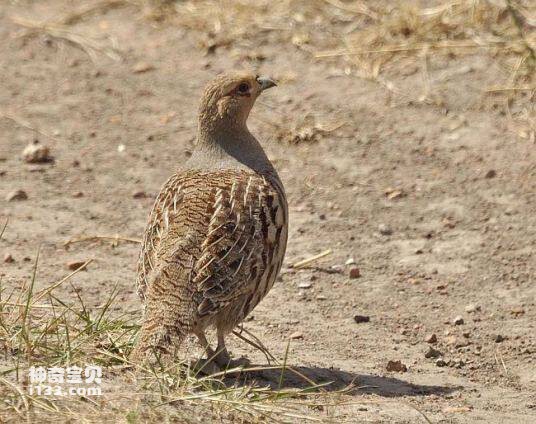Perdix dauurica
IUCN
LCBasic Information
Scientific classification
- name:Perdix dauurica
- Scientific Name:Perdix dauurica,Daurian Partridge
- Outline:Landfowl
- Family:Chickeniformes P.family Partridge
Vital signs
- length:24.8-31.2cm
- Weight:262-340g
- lifetime:No textual research information is available
Feature
The face, middle throat and abdomen of the male bird are orange, with a black "U" shaped patch in the middle abdomen
Distribution and Habitat
It is distributed in China, Kazakhstan, Kyrgyzstan, Mongolia, Tajikistan, Uzbekistan. In China, it is distributed in Qinghai (Xining, Minhe, Gonghe, Ulan, Qinghai Lake), northeast China and Xinjiang, Gansu, Inner Mongolia, Hebei, Shanxi, Shaanxi.
It lives in various habitats such as plain forest grassland, shrubland grassland, low hills and farmland wasteland. In summer, it mainly lives in the open forest edge wasteland, shrubland, low mountain young forest shrubland, open forest shrubland and grassland shelterbelt. In winter, they prefer open cultivated land or marginal scrub areas. More in the sun, shelter from the wind and less snow activities, night groups live in the lowland.
Appearance
Male adult partridge: dark grayish-brown on the head, pillow and hind neck, with brown-white plumage, the ends of which often expand into points; Brown on forehead, eye first, upper eye line and both sides of head; A small dark spot at the base of the forehead, between the nostrils; The ear feathers are chestnut brown, with light yellow stripes. Both sides of upper back, lower neck and forechest are gray, mixed with brown; Some feathers have subterminal stripes. The rest of the dorsal body is brown; With fine streaks of grayish black beetles, interspersed with neatly arranged maroon stripes; The transverse spots of the overlying feathers on the tail are thinner but wider, the surface of the central three pairs of tail feathers is the same color as the back, the rest of the tail feathers are pure chestnut, and the broad secondary tip spots are darker chestnut. The shoulder and wing overlying feathers, the tertiary flight feathers and the back small overlying feathers are dark, the prima
Details
Partridge (Perdix dauurica) is known as Daurian Partridge and has three subspecies.

Partridge usually flocks except during the breeding season. Especially in autumn and winter, there are often large groups of 15-25, or even as many as 50 animals. At the end of winter, the population gradually becomes smaller, and by the breeding period, it is fully active in pairs. In the later stage of reproduction, family groups are formed, and in the autumn, a larger group is gradually formed by the addition of some scattered individuals or other groups. But it is usually a family group activity and occupies a certain area of territory. The area of the field is usually about 2 square kilometers. It is between 2 and 8 hectares in summer. The entry of foreign individuals and other groups is often driven away and sometimes even causes fights. The call is "Quack". Good at running, but also good at hiding, often stand still when in danger, curiously stretching his neck to see, if the enemy is far away, then continue to move in the opposite direction, if the danger is near, then soon drill into the nearby woods or brush, only in an emergency to take off, each flying distance is not far, generally flying about 50 meters or 100 meters that fall into the brush, When flying, the two wings incite fast and powerful, and often issue the sound of "flapping a flapping -". Flying is not high, often close to the ground flight, flying faster, but under normal circumstances rarely take off. It feeds mainly on plant foods, including young leaves, shoots, berries, stalks, etc. of shrubs and herbs, but also insects such as locusts, grasshoppers, and small spineless propellants, especially during the breeding season.
The partridge nests in the plains, valleys, streams, hay meadows, grassland young forest and mountain forest, thicket areas rich in brush and wormwood. The nest is mostly placed on the ground in tall grass or under brush, with shrubs and grass hiding, generally difficult to find. Male and female birds often nest together. The structure of the nest is very simple, mainly in the soft ground hollow dug a shallow pit, padded with hay, moss and feathers. Each clutch lays 10-17 eggs, with a maximum of 21 eggs. The color of the eggs is light brown or sandy brown, smooth without spots, the size of the eggs is 31.8-35.5×23-27.1 mm, and the weight is 8.5-13.8 grams. Incubation is shared between male and female birds, or the female incubates the eggs and the male guards the nest area. Female birds have a strong nest love. Incubation period is 23-25 days. Chicks can follow their parents the same day they hatch.
Listed on the International Union for Conservation of Nature (IUCN) 2013 Red List of Threatened Species ver 3.1 - Not Threatened (LC).
Protect wild animals and eliminate wild meat.
Maintaining ecological balance is everyone's responsibility!








